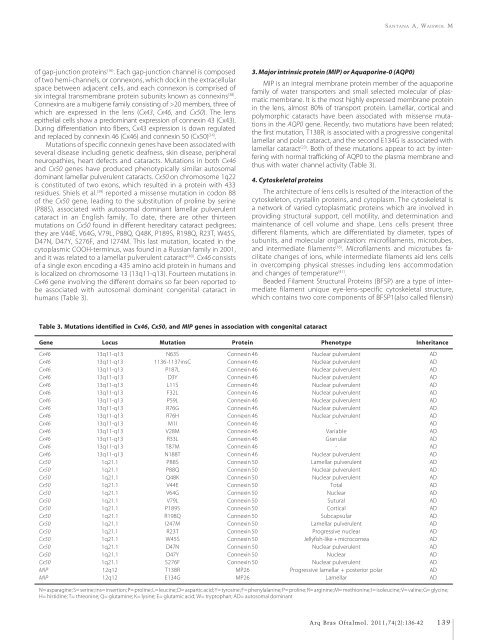a rquivos b rasileiros - Conselho Brasileiro de Oftalmologia
a rquivos b rasileiros - Conselho Brasileiro de Oftalmologia
a rquivos b rasileiros - Conselho Brasileiro de Oftalmologia
Create successful ePaper yourself
Turn your PDF publications into a flip-book with our unique Google optimized e-Paper software.
SANTANA A, WAISWOL M<br />
of gap-junction proteins (16) . Each gap-junction channel is composed<br />
of two hemi-channels, or connexons, which dock in the extracellular<br />
space between adjacent cells, and each connexon is comprised of<br />
six integral transmembrane protein subunits known as connexins (38) .<br />
Connexins are a multigene family consisting of >20 members, three of<br />
which are expressed in the lens (Cx43, Cx46, and Cx50). The lens<br />
epithelial cells show a predominant expression of connexin 43 (Cx43).<br />
During differentiation into fibers, Cx43 expression is down regulated<br />
and replaced by connexin 46 (Cx46) and connexin 50 (Cx50) (14) .<br />
Mutations of specific connexin genes have been associated with<br />
several disease including genetic <strong>de</strong>afness, skin disease, peripheral<br />
neuropathies, heart <strong>de</strong>fects and cataracts. Mutations in both Cx46<br />
and Cx50 genes have produced phenotypically similar autosomal<br />
dominant lamellar pulverulent cataracts. Cx50 on chromosome 1q22<br />
is constituted of two exons, which resulted in a protein with 433<br />
residues. Shiels et al. (39) reported a missense mutation in codon 88<br />
of the Cx50 gene, leading to the substitution of proline by serine<br />
(P88S), associated with autosomal dominant lamellar pulverulent<br />
cataract in an English family. To date, there are other thirteen<br />
mutations on Cx50 found in different hereditary cataract pedigrees;<br />
they are V44E, V64G, V79L, P88Q, Q48K, P189S, R198Q, R23T, W45S,<br />
D47N, D47Y, S276F, and I274M. This last mutation, located in the<br />
cytoplasmic COOH-terminus, was found in a Russian family in 2001,<br />
and it was related to a lamellar pulverulent cataract (40) . Cx46 consists<br />
of a single exon encoding a 435 amino acid protein in humans and<br />
is localized on chromosome 13 (13q11-q13). Fourteen mutations in<br />
Cx46 gene involving the different domains so far been reported to<br />
be associated with autosomal dominant congenital cataract in<br />
humans (Table 3).<br />
3. Major intrinsic protein (MIP) or Aquaporine-0 (AQP0)<br />
MIP is an integral membrane protein member of the aquaporine<br />
family of water transporters and small selected molecular of plasmatic<br />
membrane. It is the most highly expressed membrane protein<br />
in the lens, almost 80% of transport protein. Lamellar, cortical and<br />
polymorphic cataracts have been associated with missense mutations<br />
in the AQP0 gene. Recently, two mutations have been related;<br />
the first mutation, T138R, is associated with a progressive congenital<br />
lamellar and polar cataract, and the second E134G is associated with<br />
lamellar cataract (23) . Both of these mutations appear to act by interfering<br />
with normal trafficking of AQP0 to the plasma membrane and<br />
thus with water channel activity (Table 3).<br />
4. Cytoskeletal proteins<br />
The architecture of lens cells is resulted of the interaction of the<br />
cytoskeleton, crystallin proteins, and cytoplasm. The cytoskeletal is<br />
a network of varied cytoplasmatic proteins which are involved in<br />
providing structural support, cell motility, and <strong>de</strong>termination and<br />
maintenance of cell volume and shape. Lens cells present three<br />
different filaments, which are differentiated by diameter, types of<br />
subunits, and molecular organization: microfilaments, microtubes,<br />
and intermediate filaments (16) . Microfilaments and microtubes facilitate<br />
changes of ions, while intermediate filaments aid lens cells<br />
in overcomping physical stresses including lens accommodation<br />
and changes of temperature (41) .<br />
Bea<strong>de</strong>d Filament Structural Proteins (BFSP) are a type of intermediate<br />
filament unique eye-lens-specific cytoskeletal structure,<br />
which contains two core components of BFSP1(also called filensin)<br />
Table 3. Mutations i<strong>de</strong>ntified in Cx46, Cx50, and MIP genes in association with congenital cataract<br />
Gene Locus Mutation Protein Phenotype Inheritance<br />
Cx46 13q11-q13 N63S Connexin 46 Nuclear pulverulent AD<br />
Cx46 13q11-q13 1136-1137insC Connexin 46 Nuclear pulverulent AD<br />
Cx46 13q11-q13 P187L Connexin 46 Nuclear pulverulent AD<br />
Cx46 13q11-q13 D3Y Connexin 46 Nuclear pulverulent AD<br />
Cx46 13q11-q13 L11S Connexin 46 Nuclear pulverulent AD<br />
Cx46 13q11-q13 F32L Connexin 46 Nuclear pulverulent AD<br />
Cx46 13q11-q13 P59L Connexin 46 Nuclear pulverulent AD<br />
Cx46 13q11-q13 R76G Connexin 46 Nuclear pulverulent AD<br />
Cx46 13q11-q13 R76H Connexin 46 Nuclear pulverulent AD<br />
Cx46 13q11-q13 M1I Connexin 46 - AD<br />
Cx46 13q11-q13 V28M Connexin 46 Variable AD<br />
Cx46 13q11-q13 R33L Connexin 46 Granular AD<br />
Cx46 13q11-q13 T87M Connexin 46 - AD<br />
Cx46 13q11-q13 N188T Connexin 46 Nuclear pulverulent AD<br />
Cx50 1q21.1 P88S Connexin 50 Lamellar pulverulent AD<br />
Cx50 1q21.1 P88Q Connexin 50 Nuclear pulverulent AD<br />
Cx50 1q21.1 Q48K Connexin 50 Nuclear pulverulent AD<br />
Cx50 1q21.1 V44E Connexin 50 Total AD<br />
Cx50 1q21.1 V64G Connexin 50 Nuclear AD<br />
Cx50 1q21.1 V79L Connexin 50 Sutural AD<br />
Cx50 1q21.1 P189S Connexin 50 Cortical AD<br />
Cx50 1q21.1 R198Q Connexin 50 Subcapsular AD<br />
Cx50 1q21.1 I247M Connexin 50 Lamellar pulverulent AD<br />
Cx50 1q21.1 R23T Connexin 50 Progressive nuclear AD<br />
Cx50 1q21.1 W45S Connexin 50 Jellyfish-like + microcornea AD<br />
Cx50 1q21.1 D47N Connexin 50 Nuclear pulverulent AD<br />
Cx50 1q21.1 D47Y Connexin 50 Nuclear AD<br />
Cx50 1q21.1 S276F Connexin 50 Nuclear pulverulent AD<br />
MIP 12q12 T138R MP26 Progressive lamellar + posterior polar AD<br />
MIP 12q12 E134G MP26 Lamellar AD<br />
N= asparagine; S= serine; ins= insertion; P= proline; L= leucine; D= aspartic acid; Y= tyrosine; F= phenylalanine; P= proline; R= arginine; M= methionine; I= isoleucine; V= valine; G= glycine;<br />
H= histidine; T= threonine; Q= glutamine; K= lysine; E= glutamic acid; W= tryptophan; AD= autosomal dominant<br />
Arq Bras Oftalmol. 2011;74(2):136-42<br />
139

















